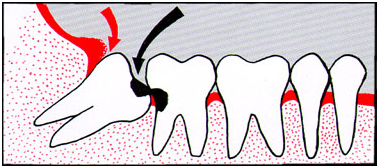Wisdom Teeth
Wisdom teeth are the last teeth to erupt in the mouth. Technically they are called the 3rd molars, because they erupt behind the 2nd molars in the mouth. We have 4 wisdom teeth, two in the upper arch and two in the lower. The wisdom teeth are the ones least needed for good oral health. They may not erupt or emerge from your gums until your late teens or early twenties - if they erupt at all. Most often they are impacted or trapped in the jaw-bone and gums, usually because there is not enough room for them in your mouth. Our jaws are smaller than those of early humans, who needed large jaws and more teeth for their tougher diet. We don't need that extra chewing power any more. In fact, wisdom teeth often do more harm than good, and in-case of any problems related to them, your dentist would suggest removing them.
CAUSES
There are 4 possible ways in which wisdom teeth may cause problems:-
- Gum disease: Most people are aware of the pain experienced during the eruption of these teeth. This generally happens because these partly erupted teeth are difficult to keep clean, and the accumulated food particles cause the gums around the tooth to get infected. Such an infection is felt as swelling and pain around the area. Sometimes the tooth is trying to erupt, but has not yet broken through the gums. When the upper tooth bites down onto this gum, pain can be caused.
- Impacted: It sometimes happens that there is not enough space in the mouth for these teeth to erupt. In such cases they may try to erupt in an abnormal direction, or may get locked into the jaw. This locking is known as impaction.
- Decay: A wisdom tooth may decay unnoticed, as they are the most difficult teeth to keep clean, being so far back into the mouth.
- Crowding: An impacted or erupting wisdom tooth can push on adjacent teeth, causing them to become crooked or even damaging them structurally.
- Cyst: If the sac that holds the crown of the wisdom tooth remains in the bone, it can fill with fluid, forming a cyst that can destroy surrounding bone.

The picture above shows an impacted wisdom tooth. The swollen gums are depicted in red, while the decayed portions are shown in black. It also shows the erupting wisdom tooth putting pressure on the adjacent tooth in front, which if allowed to continue for a longer time, could result in crowding. The position of the wisdom tooth also makes it difficult to keep that area clean, leading to decay and gum infection.
Your dental evaluation will consist of oral examination and x-rays. Your dentist may also need to know your medical history, as extraction of an impacted tooth usually is a minor surgical procedure. But the surgery is a minor one and the patient is back to work in a day or two. The x-rays show the type of impaction and thus helps the dentist plan your treatment.
Positions of Impaction:
Due to unavailability of space in the jaws, the impacted wisdom teeth grow in many different directions, commonly at an angle. The complexity of surgery depends on the type of impaction.













 044 - 24816078
044 - 24816078



